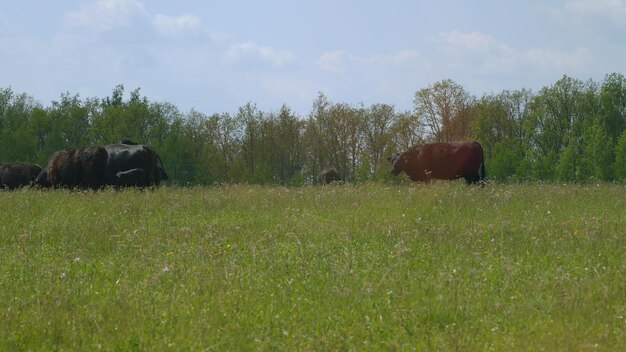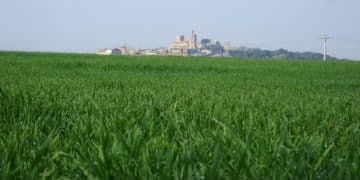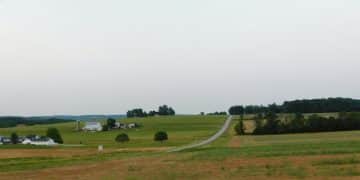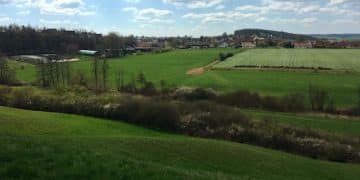Latest USDA Incentives for Sustainable Grazing Practices in 2025

The latest USDA incentives for implementing sustainable grazing practices in 2025 focus on promoting environmental stewardship, enhancing soil health, and improving livestock productivity through financial and technical assistance programs.
Are you a livestock producer looking to enhance your grazing practices while also benefiting from government support? Understanding the latest USDA incentives for implementing sustainable grazing practices in 2025 can significantly impact your operations. Let’s explore what’s on the horizon.
Understanding Sustainable Grazing Practices
Sustainable grazing practices are essential for maintaining healthy ecosystems and ensuring long-term productivity in livestock farming. These practices not only benefit the environment but also improve the economic viability of agricultural operations.
What is Sustainable Grazing?
Sustainable grazing involves managing livestock grazing to maintain or improve the health of forage plants, soil, and water resources. It aims to balance the needs of livestock production with environmental conservation.
Key Principles of Sustainable Grazing
The core principles include rotational grazing, proper stocking rates, and monitoring forage conditions to prevent overgrazing and promote biodiversity.
- Rotational Grazing: Systematically moving livestock between different paddocks to allow forage plants to recover.
- Proper Stocking Rates: Matching the number of animals to the available forage resources to prevent overgrazing.
- Monitoring Forage Conditions: Regularly assessing the health and productivity of pastures to make informed management decisions.

Sustainable grazing not only enhances the ecological health of pastures but also improves livestock health and productivity. By implementing these practices, farmers can create more resilient and profitable operations.
Overview of USDA Incentive Programs
The USDA offers a range of incentive programs designed to support farmers in adopting sustainable grazing practices. These programs provide financial and technical assistance to help producers implement conservation measures.
Environmental Quality Incentives Program (EQIP)
EQIP is one of the primary USDA programs that provides financial and technical assistance to agricultural producers to implement conservation practices. It supports a variety of sustainable grazing practices, including rotational grazing, prescribed grazing, and pasture and hayland planting.
Conservation Stewardship Program (CSP)
CSP rewards farmers who are already implementing good conservation practices and encourages them to adopt additional enhancements. It supports advanced grazing management techniques that improve soil health, water quality, and wildlife habitat.
Sustainable Agriculture Research and Education (SARE)
SARE funds research and education projects that advance sustainable agriculture. While not a direct incentive program, SARE provides valuable information and resources to farmers interested in sustainable grazing practices.
These USDA programs are instrumental in promoting sustainable grazing by providing the necessary financial and technical support. By participating in these programs, farmers can achieve both environmental and economic benefits.

Specific Incentives for Grazing Practices in 2025
In 2025, several new and updated incentives are expected to further support sustainable grazing practices. These incentives focus on addressing specific environmental and economic challenges faced by livestock producers.
Enhanced EQIP Initiatives
The EQIP program is expected to introduce enhanced initiatives that target specific grazing-related issues, such as improving soil health and reducing greenhouse gas emissions.
- Soil Health Enhancement: Incentives for practices that improve soil structure, organic matter content, and water infiltration.
- Greenhouse Gas Reduction: Support for grazing management techniques that sequester carbon and reduce methane emissions from livestock.
CSP Focus on Adaptive Grazing
CSP will likely place a greater emphasis on adaptive grazing management, which involves adjusting grazing plans based on real-time conditions and monitoring data.
- Real-Time Monitoring: Funding for technologies that monitor forage availability, animal performance, and environmental conditions.
- Data-Driven Decision Making: Support for using data to make informed grazing management decisions that optimize resource utilization.
Regional Conservation Partnership Program (RCPP)
RCPP encourages collaboration between multiple partners to address regional conservation priorities. This program can be used to support large-scale grazing management projects that involve multiple farms and organizations.
These specific incentives for 2025 aim to provide more targeted and effective support for sustainable grazing practices. By aligning with regional conservation priorities and incorporating advanced monitoring technologies, these programs can help farmers achieve greater environmental and economic outcomes.
How to Apply for USDA Grazing Incentives
Applying for USDA grazing incentives involves several steps, including understanding the eligibility criteria, preparing a comprehensive conservation plan, and submitting a complete application.
Eligibility Criteria
To be eligible for USDA grazing incentives, farmers must meet certain criteria related to land ownership, agricultural production, and conservation compliance.
- Land Ownership: Applicants must own or have control of the land on which the grazing practices will be implemented.
- Agricultural Production: Applicants must be actively engaged in agricultural production, typically involving livestock grazing.
- Conservation Compliance: Applicants must be in compliance with existing conservation requirements and regulations.
Developing a Conservation Plan
A comprehensive conservation plan is a critical component of the application process. This plan outlines the specific grazing practices to be implemented, the expected environmental benefits, and the timeline for implementation.
Step-by-Step Application Process
- Contact your local NRCS office: The Natural Resources Conservation Service (NRCS) provides technical assistance and guidance throughout the application process.
- Prepare a conservation plan: Work with NRCS staff to develop a detailed conservation plan that outlines the proposed grazing practices.
- Submit the application: Complete and submit the application form, along with the conservation plan and any required supporting documents.
- Review and approval: NRCS will review the application and conservation plan to determine eligibility and feasibility.
- Implementation and monitoring: Once approved, implement the grazing practices according to the conservation plan and monitor the results.
By following these steps and working closely with NRCS, farmers can successfully apply for USDA grazing incentives and receive the support needed to implement sustainable grazing practices.
Benefits of Implementing Sustainable Grazing Practices
Implementing sustainable grazing practices offers numerous benefits, including improved soil health, enhanced water quality, increased biodiversity, and greater economic resilience.
Improved Soil Health
Sustainable grazing practices can significantly improve soil health by increasing organic matter content, reducing erosion, and enhancing water infiltration.
Enhanced Water Quality
Proper grazing management can protect water resources by reducing runoff, preventing sedimentation, and minimizing nutrient pollution.
Increased Biodiversity
Sustainable grazing practices promote biodiversity by creating diverse plant communities, providing habitat for wildlife, and supporting beneficial insects.
Greater Economic Resilience
By improving soil health, water quality, and biodiversity, sustainable grazing practices can enhance the long-term productivity and profitability of agricultural operations.
The adoption of sustainable grazing practices can lead to a more resilient and profitable agricultural operation. These benefits contribute to both environmental sustainability and economic viability.
Case Studies of Successful Grazing Incentive Implementation
Examining case studies of successful grazing incentive implementation can provide valuable insights and inspiration for farmers considering adopting sustainable grazing practices. These examples demonstrate the real-world benefits of participating in USDA programs.
Case Study 1: Rotational Grazing in the Midwest
A farmer in Iowa implemented a rotational grazing system with support from EQIP, resulting in improved soil health, reduced erosion, and increased forage production. The rotational system allowed pastures to recover, leading to healthier and more productive grasslands.
Case Study 2: Adaptive Grazing in the Southwest
A rancher in Arizona adopted adaptive grazing management practices with assistance from CSP, enhancing water quality, increasing biodiversity, and improving livestock performance. The use of real-time monitoring data helped the rancher make informed grazing decisions, optimizing resource utilization.
Case Study 3: Collaborative Grazing Projects
A group of farmers in Montana collaborated on a regional conservation project through RCPP, implementing sustainable grazing practices across multiple farms. This collaborative effort resulted in landscape-scale conservation benefits, including improved watershed health and enhanced wildlife habitat.
These case studies highlight the diverse ways in which USDA grazing incentives can be used to support sustainable agricultural practices. By learning from these examples, farmers can gain a better understanding of the potential benefits and strategies for successful implementation.
| Key Aspect | Brief Description |
|---|---|
| 🌱 Sustainable Grazing | Managing grazing to benefit forage, soil, & water. |
| 💰 USDA Programs | EQIP, CSP, SARE offer financial and technical assistance. |
| 📝 Application Process | Contact NRCS, prepare plan, submit application. |
| 💧 Benefits | Improved soil, water, biodiversity, economic resilience. |
Frequently Asked Questions
▼
Rotational grazing involves moving livestock between different sections of a pasture to allow plants to recover. This prevents overgrazing and promotes healthier forage.
▼
EQIP provides financial and technical assistance to implement conservation practices like rotational grazing and pasture planting, supporting sustainable grazing.
▼
Adaptive grazing allows farmers to adjust grazing plans based on real-time conditions, optimizing resource utilization and improving environmental outcomes.
▼
Contact the local NRCS office to develop a conservation plan and apply. Ensure you meet the eligibility criteria and submit all required documents.
▼
Healthy soil improves forage production, water infiltration, and carbon sequestration, enhancing the overall sustainability and productivity of grazing lands.
Conclusion
Understanding and utilizing the latest USDA incentives can significantly benefit livestock producers aiming to implement sustainable grazing practices in 2025. By taking advantage of these programs, farmers can enhance their operations while contributing to a healthier environment.





